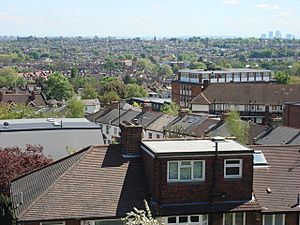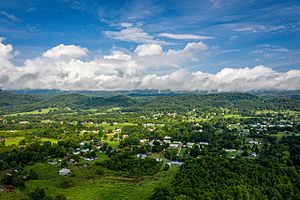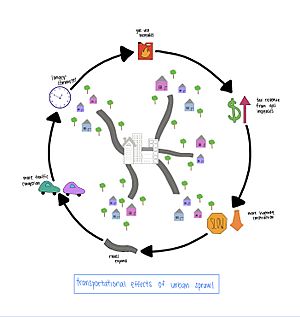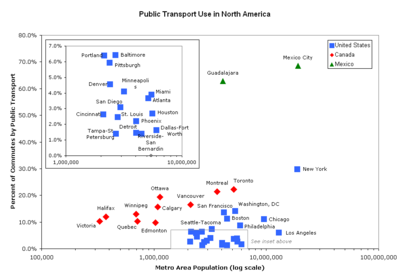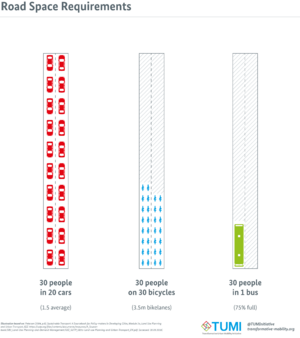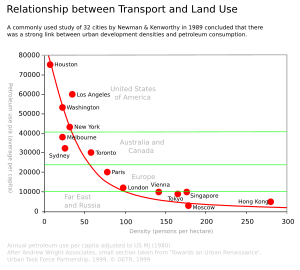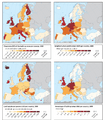Urban sprawl facts for kids
Urban sprawl is the name of a city growing in areas which have been unpopulated so far. This growth happens once the city has reached a certain size. In general, this growth also happens without regard for the planned growth, called urban planning. In the Middle Ages, there was the benefit of being protected when people lived inside the city. In modern times, there is no such benefit, and the only disadvantage is that it takes longer for people to get to the city center. People disagree about the exact definition of urban sprawl and how to measure it.
The term urban sprawl is a political one, and almost always has a negative connotation (usually that of the uncontrolled growth of a city).
Contents
Characteristics
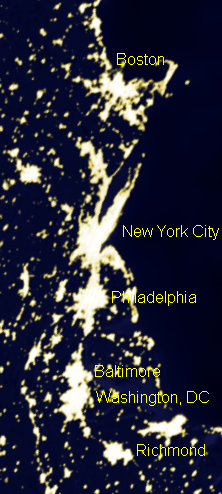
Single-use development
This refers to a situation where commercial, residential, institutional and industrial areas are separated from one another. Consequently, large tracts of land are devoted to a single use and are segregated from one another by open space, infrastructure, or other barriers. As a result, the places where people live, work, shop, and recreate are far from one another, usually to the extent that walking, transit use and bicycling are impractical, so all these activities generally require a car. The degree to which different land uses are mixed together is often used as an indicator of sprawl in studies of the subject.
Job sprawl and spatial mismatch
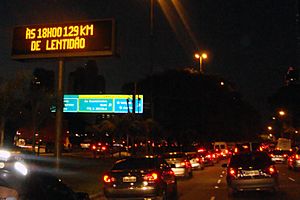
Job sprawl is another urban sprawl characteristic. It means that the majority of jobs in a given metropolitan area are located outside of the main city's central business district (CBD), and increasingly in the suburban periphery. It is often the result of many companies' desire to locate in low-density areas that are often more affordable and offer potential for expansion.
Spatial mismatch is defined as the situation where poor urban, predominantly minority citizens are left without easy access to entry-level jobs, as a result of increasing job sprawl and limited transportation options to facilitate a reverse commute to the suburbs.
Low-density
Sprawl often refers to low-density development. There is no precise definition of "low density", but it might commonly mean Single-family homes on large lots. Such buildings usually have fewer stories and are spaced farther apart, separated by lawns, landscaping, roads or parking lots. In the United States 2–4 houses per acre (5–10 per hectare) might be considered low-density while in the UK 8–12 per acre (or 20–30 per hectare) would still be considered low-density. Because more automobiles are used in the USA, much more land is designated for parking. The impact of low density development in many communities is that developed or "urbanized" land is increasing at a faster rate than the population is growing.
Overall density is often lowered by "leapfrog development". This term refers to the relationship, or lack of it, between subdivisions. Such developments are typically separated by large green belts, i.e. tracts of undeveloped land, resulting in an overall density far lower even than the low density indicated by localized per-acre measurements. This is a 20th and 21st century phenomenon generated by the current custom of requiring a developer to provide subdivision infrastructure as a condition of development. Usually, the developer is required to set aside a certain percentage of the developed land for public use, including roads, parks and schools. In the past, when a local government built all the streets in a given location, the town could expand without interruption and with a coherent circulation system, because it had condemnation power. Private developers generally do not have such power (although they can sometimes find local governments willing to help), and often choose to develop on the tracts that happen to be for sale at the time they want to build, rather than pay extra or wait for a more appropriate location.
Conversion of agricultural land to urban use
Land for sprawl is often taken from fertile agricultural lands; the extent of modern sprawl has consumed a large amount of the most productive agricultural land, as well as forest, desert and other wilderness areas.
Housing subdivisions
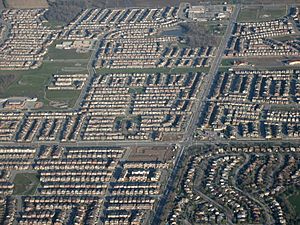
Housing subdivisions are large tracts of land consisting entirely of newly built residences. Subdivisions often incorporate curved roads and cul-de-sacs. These subdivisions may offer only a few places to enter and exit the development, causing traffic to use high volume collector streets. All trips, no matter how short, must enter the collector road in a suburban system.
Lawn
After the Second World War, residential lawns became commonplace in suburbs, notably, but not exclusively in North America. The development of country clubs and golf courses in the early 20th century further promoted lawn culture in the United States. Lawns now take up a significant amount of land in suburban developments, contributing to sprawl.
Commercial developments
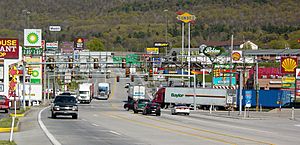
In areas of sprawl, commercial use is generally segregated from other uses. In the U.S. and Canada, these often take the form of strip malls, which refer to collections of buildings sharing a common parking lot, usually built on a high-capacity roadway with commercial functions (i.e., a "strip"). Similar developments in the UK are called Retail Parks. Strip malls consisting mostly of big box stores or category killers are sometimes called "power centers" (U.S.). These developments tend to be low-density; the buildings are single-story and there is ample space for parking and access for delivery vehicles.
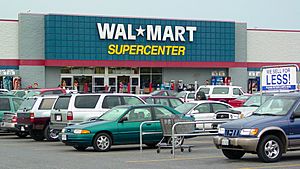
Another prominent form of retail development in areas characterized by sprawl is the shopping mall. Unlike the strip mall, this is usually composed of a single building surrounded by a parking lot that contains multiple shops. The function and size is also distinct from the strip mall. The focus is almost exclusively on recreational shopping rather than daily goods. Shopping malls also tend to serve a wider (regional) public and require higher-order infrastructure such as highway access and can have floorspaces in excess of 1 million sq ft (93,000 m2).
Fast food chains are often built early in areas with low property values where the population is expected to boom and where large traffic is predicted, and set a precedent for future development. Eric Schlosser, in his book Fast Food Nation, argues that fast food chains accelerate suburban sprawl and help set its tone with their expansive parking lots, flashy signs, and plastic architecture (65). Duany Plater Zyberk & Company believe that this reinforces a destructive pattern of growth in an endless quest to move away from the sprawl that only results in creating more of it.
Effect
Urban sprawl is associated with a number of negative environmental outcomes.
One of the major environmental problems associated with sprawl is land loss, habitat loss and subsequent reduction in biodiversity. A review by Czech and colleagues finds that urbanization endangers more species and is more geographically ubiquitous in the mainland United States than any other human activity. Urban sprawl is disruptive to native flora & fauna and introduces invasive plants into their environments. Although the effects can be mitigated through careful maintenance of native vegetation, the process of ecological succession and public education, sprawl represents one of the primary threats to biodiversity.
Other problems include:
- flooding, which results from increased impervious surfaces for roads and parking (see urban runoff)
- increased temperatures from heat islands, which leads to a significantly increased risk of mortality in elderly populations.

Sprawl increases water pollution as rain water picks up gasoline, motor oil, heavy metals, and other pollutants in runoff from parking lots and roads.
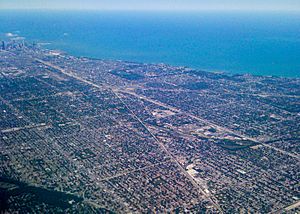
Health
Sprawl leads to increased driving, which in turn leads to vehicle emissions that contribute to air pollution and its attendant negative impacts on human health. In addition, the reduced physical activity implied by increased automobile use has negative health consequences. Sprawl significantly predicts chronic medical conditions and health-related quality of life, but not mental health disorders. The American Journal of Public Health and the American Journal of Health Promotion, have both stated that there is a significant connection between sprawl, obesity, and hypertension. Loud vehicles can cause stress, prevent sleep, and minimize social interactions in public for people living in cities (especially homeless people).
Sprawl also reduces the chance that people will take the bicycle for their commute which would be better for their health. Bicycles are a common mode of transportation for those living in urban centers due to many factors. One major factor many people consider relates to how, when one rides a bike to, say, their workplace, they are exercising as they do so. This multi-tasking is better for one's health than automatic transport.
Safety
A heavy reliance on automobiles increases traffic throughout the city as well as automobile crashes, pedestrian injuries, and air pollution. Motor vehicle crashes are the leading cause of death for Americans between the ages of five and twenty-four and is the leading accident-related cause for all age groups. Residents of more sprawling areas are generally at greater risk of dying in a car crash due to increased exposure to driving. Evidence indicates that pedestrians in sprawling areas are at higher risk than those in denser areas, although the relationship is less clear than for drivers and passengers in vehicles.
Research covered in the Journal of Economic Issues and State and Local Government Review shows a link between sprawl and emergency medical services response and fire department response delays.
Economy
Living in larger, more spread out spaces generally makes public services more expensive. Since car usage becomes endemic and public transport often becomes significantly more expensive, city planners are forced to build highway and parking infrastructure, which in turn decreases taxable land and revenue, and decreases the desirability of the area adjacent to such structures. Providing services such as water, sewers, road maintenance, and electricity is also more expensive per household in less dense areas, given that sprawl increases lengths of power lines, roads, and pipes, necessitating higher maintenance costs.
Residents of low-density areas spend a higher proportion of their income on transportation than residents of high density areas.
Social
Urban sprawl may be partly responsible for the decline in social capital in the United States. Compact neighborhoods can foster casual social interactions among neighbors, while sprawl creates barriers. Sprawl tends to replace public spaces with private spaces such as fenced-in backyards.
Numerous studies link increased population density with increased aggression. Some people believe that increased population density encourages crime and anti-social behavior. It is argued that human beings, while social animals, need significant amounts of social space or they become agitated and aggressive. However, the relationship between higher densities and increased social pathology has been largely discredited.
Images for kids
-
A majority of Californians live, commute, and work in the vast and extensive web of Southern California freeways.
-
Many Canadian cities feature numerous pockets of high density throughout even their most distant suburbs. As a result, some Canadian suburbs have skylines that rival large American cities. Pictured is Burnaby, British Columbia, a suburb of Vancouver.
See also
 In Spanish: Dispersión urbana para niños
In Spanish: Dispersión urbana para niños


